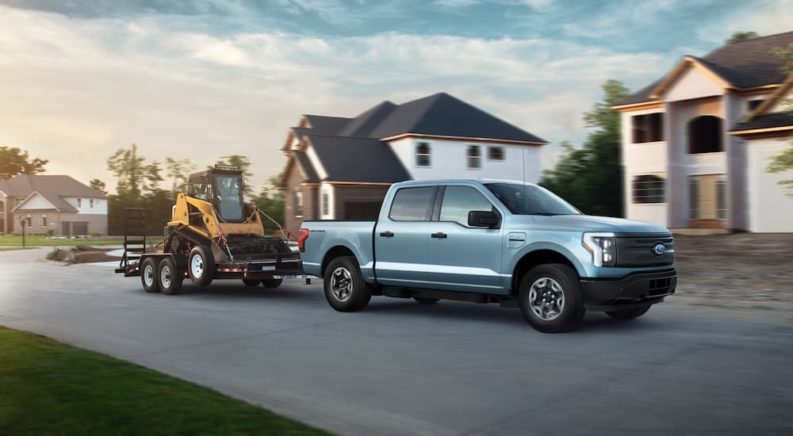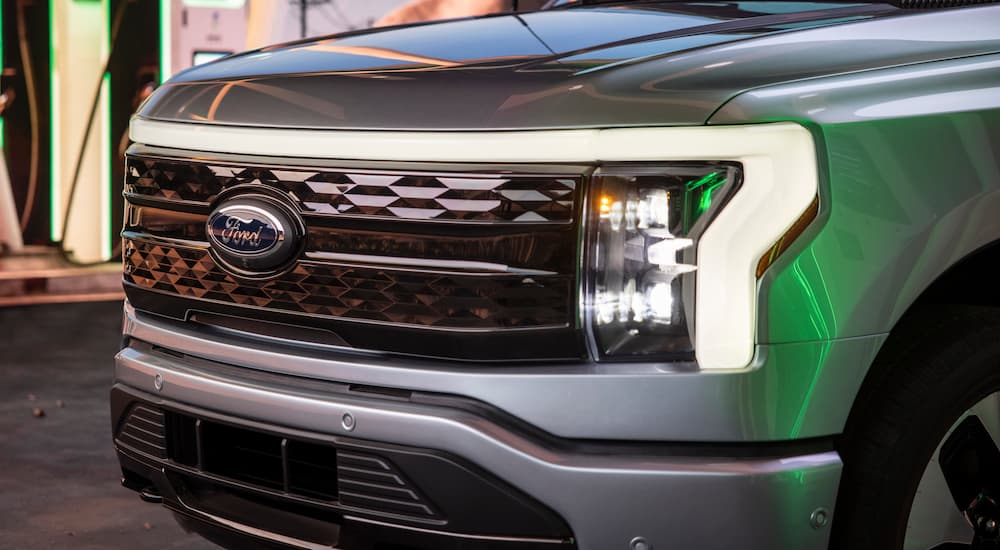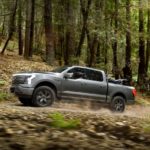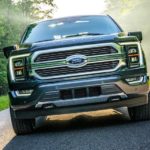While baseball, jazz, and the Constitution have been called America’s greatest contributions to civilization, we would like to submit one more contender for your consideration: the pickup truck. Ever since the first hauling box was installed on a modified Model T chassis in 1913, drivers have not been able to get enough of these versatile vehicles. As one of the first manufacturers to bring the pickup to the masses, it’s little surprise that Ford’s dominance in the pickup segment continues to this day. However, the move to electric vehicles threatens to shake the Blue Oval’s decades-long dominance as EV startups release their own models – comparing the 2022 Ford F-150 Lighting vs 2022 Rivian R1T, does Ford have what it takes to stay on top?
There From The Beginning
The first pickup that would be recognizable to today’s drivers rolled off Ford’s production line in 1925. Featuring a steel body, adjustable liftgate, and heavy-duty rear springs, the Ford Model T Runabout with Pickup Body is the granddaddy of the modern truck, if a bit of a mouthful. But Ford not only introduced some of the earliest pickups, but they also provided the basic building blocks for others to experiment with as well. Back then, most auto manufacturers sold the chassis as a standalone product, with third-party companies adding their own bodies before marketing them to consumers. The Model T was one of the most popular platforms on which to build out early pickups, making the name Ford synonymous with the pickup since its earliest days.
With the 2022 F-150 Lightning, Ford hopes to make a similar impact on the growing electric truck market. While early hybrids and EVs skewed to the smaller, more aerodynamic side, the F-150 Lightning is here to prove that it can offer the same efficiency without sacrificing the rugged functionality drivers have come to expect from their pickup. Featuring a five-passenger SuperCrew cab standard, the F-150 Lightning boasts 426 horsepower and 775 pound-feet of torque with the standard battery, which gets bumped up to 563 horsepower with the addition of the available extended-range battery. Those stats alone would be enough for the F-150 Lightning to become a serious contender in the sector, but when you factor in the all-wheel drive truck’s 10,000 pounds of towing capacity, skid plates, and full-size spare, you’ve got one of the most rugged and capable off-road EVs on the market.

A Brand-New Brand
The R1T is an intriguing player in the budding EV wars. Sized somewhere between a midsize and half-ton pickup, Rivian is more than capable of the feats of strength consumers will expect for the price. The R1T can tow up to 11,000 pounds, climb rocks with the best of them, and like many EVs, produce the type of instantaneous power that’s sure to impress those whose preconceived notions about electric vehicles are stuck firmly in the Prius era. The R1T does it better than many with a unique setup that sees each wheel get its own electric motor, allowing it to deliver 415-horsepower to the front wheels and 420 horsepower in the rear. With a number of customized drive modes, the R1T is impressively customizable, giving drivers the opportunity to tune every drive to their liking.
It might be looking like a fair fight up until now, but then we get to the R1T’s price: $67,500 to the F-150 Lightning’s $39,974. Consumers expect to pay more for cutting-edge offerings from brands on the rise, with the exclusivity often offsetting the premium price tag, but the R1T hardly exists in the same tax bracket as the F-150 Lightning. To some degree, this can be written off to economies of scale: Ford has 186,000 employees turning out between 5 and 6 million units per year, and it’s hard to compete with the country’s second best-selling auto manufacturer. With optional accessories and trim packages added on, the F-150 Lightning can ring in as high as $90,000 – about the same as the fully loaded R1T – but the drastically lower starting price has the Lightning poised to capture market share in a way the R1T can’t hope to emulate. More vehicles on the road typically means lower repair costs down the road, so score another point for the higher-volume Ford on that one too.
Old and New
In an era of business where “disruption” is the watchword, and flash-in-the-pan startups generate little aside from excitement (and the occasional flamethrower), Ford is refreshingly old-fashioned while still embracing coming trends. Over its 100-plus years in the industry, Ford has produced over 150 different vehicles in North America alone: a legacy that many of today’s fledgling auto brands cannot hope to compete with. The F-150 Lightning isn’t only one of the most buzzworthy EVs in recent memory; it’s also the first generator we’ve ever been this excited about.
Equipped with a 125 kWh standard-range battery or a 170 kWh extended-range pack, the Lightning can even be used to power one’s home in case of an outage or emergency. Simply connect the pickup to the hardwired wall charger, and the Intelligent Backup Power system will feed up to 9.6 kW to your home grid. This isn’t some trickle of juice either, with the ability to power everything from refrigerators and televisions to power tools and blenders. The R1T could pull off a similar trick, but Rivian hasn’t made it as easy, requiring drivers to purchase third-party bi-directional charging stations to provide the same functionality. The R1T does include ample 110-watt outlets throughout the cabin, but jerry-rigging a rat’s nest of extension cords from the driveway to the house in the middle of a power outage doesn’t sound like a lot of fun to us.
Can A Startup Compete?
While the 2022 Rivian R1T looks like a promising newcomer in the category, it’s hard to ignore the brand’s non-existent track record. Founded in 2009, Rivian has yet to sell a vehicle. The long-awaited R1T and the accompanying R1S SUV represent the brand’s first two commercial offerings, but the truck has already missed its original July 2021 debut owing to supply chain issues and semiconductor chip shortages tied to the global pandemic. Ford hasn’t been immune to these same market forces, but the brand’s deep coffers and experience weathering unforeseen circumstances have allowed it to move more nimbly during these unprecedented times.
Case in point: in contrast to the lagging Rivian, Ford recently announced plans to double upcoming production goals based on strong consumer interest. With over 120,000 pre-orders already in the book, the Detroit auto manufacturer will pour an additional $850 million into its production budget in hopes of producing as many as 80,000 F-150 Lightnings annually by 2024. The initial run of the all-electric truck will see 15,000 units rolling off the production line for the 2022 model year, with 55,000 to follow in 2023. Ford has announced an ambitious goal of selling 160,000 EV pickups each year by 2026 – which would be almost 20 percent of F-series sales as a whole – proving that the auto manufacturer is all-in on the next generation of all-electric vehicles.
Rivian has experienced some impressive growth over the last decade and now employs over 3,000 workers with two separate production lines at its Normal, Illinois, manufacturing facility. While they’ve yet to launch any products, the auto brand has landed a deal to supply Amazon with 100,000 electric delivery vans as part of the online retailer’s goal of launching a 100 percent renewable energy-powered fleet by 2030. Things are certainly moving in the right direction for the newcomer, but it’s still too early to tell whether Rivian will achieve the rarefied success of a brand like Tesla or be relegated to the annals of automotive history along with Delorean and Edsel (and even the “success” stories often have trouble delivering on their lofty promises, as any Tesla fanboy still waiting for his Cybertruck can tell you).
The Jury Is Still Out
The EV market is particularly fertile ground for these aspiring automakers, but with so many new players entering the market, the smart bet is to wait a little while to see which brands rise above the fray. These boutique manufacturers seem good on paper, but just as anyone who’s become inordinately excited about a failed Kickstarter campaign can tell you, bringing those dreams to market often proves difficult. Ford’s record on the pickup front speaks for itself, with over 100 years and millions of trucks to its name, and the Big Blue Oval is sure to be a major player in the segment for years to come. The company’s resources, institutional knowledge, and hard-earned consumer trust make it an immediate contender in any venture, and by applying the vaunted F-150 badge to the new EV, Ford is well-positioned to extend its dominance in the pickup sector well into the new all-electric era.





